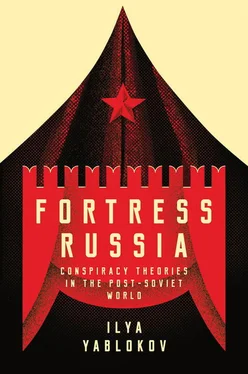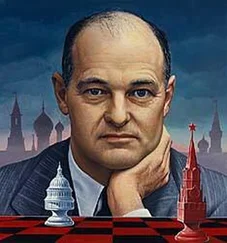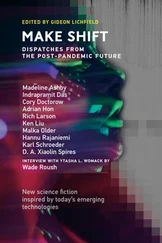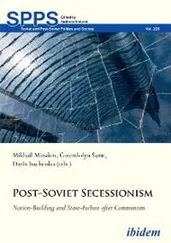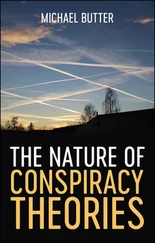The idea that a ‘subversive agency’ among the political elites of the Soviet Union and Russia had contributed to the Soviet collapse was fundamental to populist rhetoric on the part of politicians and intellectuals. These ideas appealed to some sections of Russian society and supplied the authorities with arguments with which to undermine the reputations of political opponents who had reputedly benefitted from the Soviet collapse. The attempt to impeach Yeltsin in 1999 had shown that anti-Western conspiracy theories about the Soviet collapse could serve as a political tool, rather than simply remaining an element in fringe ideologies. It demonstrated the potential of creating short-term alliances with diverse political groups to pursue political goals. At the same time, the attempted impeachment became the starting point for the relocation of these theories from the opposition’s ideological arsenal to official political discourse.
The active use of the conspiratorial reading of the Soviet collapse by Russian officials demonstrates the tactics of the Russian establishment in the 2000s. They have adapted the ideology of the national-patriotic opposition and used it against the Kremlin’s current rivals, the liberal democratic and radical nationalist opposition. At first, Kremlin officials borrowed the conspiratorial interpretation of the Soviet collapse from the intellectual set of ideas developed by national patriots who opposed the government. Later, these same people became great advocates of the current regime. Aleksandr Dugin, who called for a complete standoff with the West, as discussed in Chapter 2, joined the coalition in support of Putin in the presidential elections in 2012 and two years later stood at the forefront of the Russian campaign to support the annexation of Crimea. Another leader of the national-patriotic movement, whose media outlet was the key voice of the anti-Yeltsin coalition in the 1990s, was Aleksandr Prokhanov; in an interview with The New York Times in 2014, he noted with satisfaction that he was ‘regularly invited to Kremlin events’ (Barry, 2014). The transformation of these public intellectuals from leaders of the anti-government camp in the 1990s into the Kremlin’s closest allies in the 2000s shows that the Kremlin has taken every advantage to ensure that it has maximum support from diverse communities. In fact, as this book argues, public intellectuals and the authorities both benefit from their collaboration. The active involvement of public intellectuals in the production and dissemination of anti-Western conspiracy theories raises their public profile and gains them support – and funding – from the Kremlin. In turn, the Kremlin encourages the intellectuals’ endeavours to disseminate anti-Western conspiracy theories as they help reinforce the power claims of political elites.
In the 2000s, the ruling political elites, with the support of prominent public intellectuals such as Gleb Pavlovskii, invested a great deal of time and money in creating a network of public intellectuals and media personalities who even today continue to produce anti-Western conspiracy theories and disseminate them among the Russian public. Regardless of political preferences or professional background, intellectuals loyal to the Kremlin portray the West both as the main external enemy of Russia, and as controller of domestic opposition to Putin. At the same time, the efforts of these intellectuals transformed the figure of Putin into an icon of resistance to the West and the only guarantor of Russia’s sovereignty. Moreover, the image of Putin has evolved internationally and has become the embodiment of resistance to the West and the New World Order in the eyes of various foreign audiences. The Kremlin’s engagement with far-right and far-left organizations around the world (Shekhovtsov, 2018) plays an important role in the Kremlin’s efforts to spread its vision of global affairs, in which anti-Western and anti-American conspiracy theories have become a tool for undermining the credibility of the US and EU governments.
Populist theories of Western conspiracy produced by public intellectuals became a way of legitimizing authoritarian rule and delegitimizing Putin’s opponents. The case of Mikhail Khodorkovsky was a watershed in the conspiratorial practices of the Kremlin. One year after Khodorkovsky was put in prison, Ukraine experienced its first colour revolution; this scared the Kremlin and opened the gates for all possible conspiracy allegations aimed at protecting the current regime. Numerous think tanks and foundations led by prominent public intellectuals became an integral part of policies meant to promote Vladislav Surkov’s idea that Russia was a ‘sovereign democracy’. Chapter 4shows how Surkov’s definition of the West as a competitor helped shift anti-Western rhetoric from the margins of political discourse into a discussion on economy and finance. This, in turn, imbued debates on Russian greatness with pride in the country’s vast natural resources and provided an explanation of the reasons for the West’s hostility towards Russia. However, Surkov represented Western societies as complex and pluralistic, with only some specific groups wishing Russia ill. This change in anti-Western rhetoric, which had traditionally represented the West as a single, monolithic entity, contributed to the further legitimization of anti-Western conspiracy mythmaking in the public sphere: it was more nuanced and hence more believable.
As well as meeting clearly political needs, the growing presence of anti-Western conspiracy theories in official discourse can be explained by the ability of conspiracy theories to create national identities and promote national cohesion. Russian political and intellectual elites in the 2000s opted for anti-Western conspiracy theories as a method of nation-building. They created a dualistic worldview in which the Russian nation stood against its ultimate, conspiring ‘Other’, the United States.
The Pussy Riot affair is a case in point. Conspiracy theories about the band’s threat to Russian national cohesion were used to link its supporters to protesters demanding fair elections in the country. The campaign against Pussy Riot was a media-constructed event aimed at polarizing society in the post-electoral period. It served as a bridge between a conspiratorial propaganda campaign against the United States, which was embarked on to ensure Putin’s victory, and the anti-opposition campaign in the aftermath of the elections. The corpus of anti-Western conspiracy notions used in the debates around the Pussy Riot affair set the parameters of domestic politics during Putin’s third term and provided a counter-balance to the opposition’s anti-Kremlin views.
This division of the world enabled the Kremlin to simulate cohesion within the highly heterogeneous Russian society on the basis of shared animosity towards the USA. Active social mobilization against the allegedly destructive US policy towards Russia peaked during the electoral cycles in 2007–8 and 2011–12. However, the wave of rallies against the regime from 2011 onwards, the subject of Chapter 6, came as a surprise to the Kremlin and radicalized the search for a domestic ‘conspiring Other’ connected to the USA and turned resistance to the USA into the basis for legislative initiatives. The Pussy Riot trial was a timely event for the political authorities as it allowed Russian society to be split between the ‘Russian Orthodox people’ and the subversive ‘Other’, in the aftermath of a difficult electoral campaign. However, efforts to construct a sense of nation based on an alleged Western-inspired conspiracy against Orthodoxy was only partly successful, and only in the short term.
The impact of anti-Western conspiracy theories on political developments in Putin’s Russia had never been so apparent as it was during the parliamentary and presidential elections of 2007–8 and 2011–12, when the struggle to protect access to power was particularly intense. As Chapter 6shows, well-orchestrated campaigns throughout both electoral cycles portrayed Putin as the embodiment of ‘the Russian people’, and the only person who could guarantee the country’s sovereignty and independence from the West. The Kremlin wanted to create an ‘overwhelming majority’ of Putin supporters as a way of consolidating the elites and demonstrating the regime’s efficiency (Rogov, 2013). Various anti-Western conspiracy theories, which had been developed by public intellectuals and pro-Kremlin politicians, became an efficient instrument of popular mobilization. The two electoral periods of the new millennium became revealing demonstrations of how various state and private institutions cooperated in an effort to maintain the regime. Public intellectuals and think tanks worked together with the state-aligned media to aggressively promote fears of a colour revolution in Russia, which was reportedly being planned by the West and its allies within Russia. In turn, in their public speeches, top-ranking politicians, including Putin, articulated anti-Western conspiratorial notions. This confirmed the conspiracy narrative as an inherent and legitimate part of official political discourse.
Читать дальше
Конец ознакомительного отрывка
Купить книгу
